Memorial sites
to discover on the Canal du Midi
The Canal du Midi is a practical engineering structure, but it is also monumental. In the regions it crosses through, the local population should not only see the canal as a practical feature, it should also hold significant symbolic value.
Because in fact the Canal du Midi was created as a symbol of Royal power, that of Louis XIV who wanted to leave his mark and turn France into a global economic power.
A canal bearing the image of the Sun King
A Royal canal
As you know, the Canal du Midi has not always been known as such. From construction up until the French Revolution, it was known as the Canal Royal du Languedoc.
The name given to the waterway illustrated the symbolic nature of this structure and its role in developing the regions. With this name, King Louis XIV left his mark on his Languedoc territory.
A masterpiece to illustrate the power of the King
Riquet may have been the official owner of the canal seigneury, but the King remained its symbolic owner.
This hierarchy in the possession of the structure was illustrated by the procedure Riquet had to follow to obtain authorisations and credit, and it was also a way to pay tribute to the King. Therefore, when Riquet planned to build a new town in Naurouze (a project that never actually took shape), he included in the plans a statue of Louis XIV at the centre of an octogonal-shaped basin. This tribute could have been sincere and spontaneous, but it most definitely reflects the position Riquet found himself in.
Likewise, some time after the death of Riquet, Vauban also made sure to build engineering structures that respected the criteria in terms of appearance, reflecting the power and greatness of Royal engineering.
The French Revolution
and the abolition of Royal symbols
There was one main objective of the French Revolution: to overthrow all symbols of the former regime.
Any features of the canal that represented royalty were therefore removed. The Languedoc crest represented by an Occitan cross on some of the keystones on the bridges (Gardouch, Argeliers) was also removed, as well as the decorative features in tribute to the King on the downstream side of Cammazes tunnel, and the coat of arms of archbishop Arthur Richard Dillon, developer of the Canal de Jonction, sculpted on the façade of the Gailhousty building (restored in around 2010).
This was also the time when the name of the Canal Royal du Languedoc was changed and it became the Canal du Midi.
Tributes to Riquet on the Canal du Midi
An obelisk in Riquet's memory
In 1824, Pierre-Paul Riquet's heirs held stakes in the Compagnie du Canal.
To symbolise their family, the canal creator's family, they decided to erect a monument in Riquet's memory in Naurouze, on the mysterious stones laid out in an almost magical way on the Lauragaise plain.
The first project was to mount a statue of Riquet on a column, but in the end a solar symbol of Ancient Egypt - an obelisk - was chosen, as a symbol of eternity for this place.
Commemorative statues
In the mid-19th century, several statues were erected in tribute to Pierre-Paul Riquet, in 1838 in Béziers and also in 1853 in Toulouse. These commemorative monuments play a part in erasing the memory of the Canal Royal. The canal was no longer considered a symbol of Louis XIV's reign, but as a masterpiece built by Riquet.
Riquet's burial in Saint-Sernin
Pierre-Paul Riquet was buried at Saint-Etienne cathedral in Toulouse. A plaque in his memory can be seen on a pillar at the entrance to his crypt with the words (in French):
"AT THE FRONT OF THIS PILLAR / LIES THE BODY / OF PIERRE PAUL DE RIQUET / BARON DE BONREPOS / CREATOR OF THE CANAL DES DEUX MERS / BORN IN BÉZIERS IN 1604 AND DIED ON 1 OCTOBER 1680 / THE CRYPT THAT HOUSES HIS REMAINS WAS FOUNDED / IN 1842 THANKS TO THE LOVING DEVOTION OF / HIS DESCENDANTS AND A / FAMILY GATHERS HERE IN THE PRESENCE OF GOD / TO WORSHIP THIS GRACIOUS GENIUS / ALREADY RECOGNISED AS SUCH BY THE PUBLIC / HE WHO CREATED THE WEALTH OF LANGUEDOC"
Other symbolic features
of the Canal du Midi
Along the Canal du Midi, there are other decorative symbols that contribute to the monumental value of the structure. Among these features are the marble bas-relief on the Ponts-Jumeaux (twin bridges) in Toulouse, the bases for statues at the end of the canalet in Agde and the memorial stone of Saint Ferréol. There are also other features that represent certain events or accidents related to the canal's history.

Bas relief des ponts-jumeaux - VNF, Sylvain Cambon
These commemorative objects could be lead plaques that describe an event, such as the visit from the United States Minister to France, Thomas Jeffersson, in 1787, or markers such as the ones at Répudre aqueduct or Fonfile lock which show how high the waters rose during the floods of 1843.














